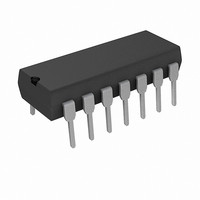PIC16F1824-I/P Microchip Technology, PIC16F1824-I/P Datasheet - Page 110

PIC16F1824-I/P
Manufacturer Part Number
PIC16F1824-I/P
Description
IC PIC MCU 8BIT 14KB FLSH 14PDIP
Manufacturer
Microchip Technology
Series
PIC® XLP™ 16Fr
Datasheets
1.PIC16F722-ISS.pdf
(8 pages)
2.PIC16F1824-ISL.pdf
(2 pages)
3.PIC16F1824-ISL.pdf
(419 pages)
4.PIC16F1824-ISL.pdf
(10 pages)
5.PIC16F1824-IP.pdf
(10 pages)
Specifications of PIC16F1824-I/P
Core Processor
PIC
Core Size
8-Bit
Speed
32MHz
Connectivity
I²C, SPI, UART/USART
Peripherals
Brown-out Detect/Reset, POR, PWM, WDT
Number Of I /o
11
Program Memory Size
7KB (4K x 14)
Program Memory Type
FLASH
Eeprom Size
256 x 8
Ram Size
256 x 8
Voltage - Supply (vcc/vdd)
1.8 V ~ 5.5 V
Data Converters
A/D 8x10b
Oscillator Type
Internal
Operating Temperature
-40°C ~ 85°C
Package / Case
14-DIP (0.300", 7.62mm)
Processor Series
PIC16F
Core
PIC
3rd Party Development Tools
52715-96, 52716-328, 52717-734
Development Tools By Supplier
PG164130, DV164035, DV244005, DV164005
Lead Free Status / RoHS Status
Lead free / RoHS Compliant
Lead Free Status / RoHS Status
Lead free / RoHS Compliant, Lead free / RoHS Compliant
- PIC16F722-ISS PDF datasheet
- PIC16F1824-ISL PDF datasheet #2
- PIC16F1824-ISL PDF datasheet #3
- PIC16F1824-ISL PDF datasheet #4
- PIC16F1824-IP PDF datasheet #5
- Current page: 110 of 419
- Download datasheet (4Mb)
PIC16(L)F1824/1828
11.3
It is important to understand the Flash program
memory
operations. Flash program memory is arranged in
rows. A row consists of a fixed number of 14-bit
program memory words. A row is the minimum block
size that can be erased by user software.
Flash program memory may only be written or erased
if the destination address is in a segment of memory
that is not write-protected, as defined in bits WRT<1:0>
of Configuration Word 2.
After a row has been erased, the user can reprogram
all or a portion of this row. Data to be written into the
program memory row is written to 14-bit wide data write
latches. These write latches are not directly accessible
to the user, but may be loaded via sequential writes to
the EEDATH:EEDATL register pair.
The number of data write latches is not equivalent to
the number of row locations. During programming, user
software will need to fill the set of write latches and ini-
tiate a programming operation multiple times in order to
fully reprogram an erased row. For example, a device
with a row size of 32 words and eight write latches will
need to load the write latches with data and initiate a
programming operation four times.
The size of a program memory row and the number of
program memory write latches may vary by device.
See
TABLE 11-1:
DS41419B-page 110
PIC16(L)F1824/
Note:
Table 11-1
Device
1828
Flash Program Memory Overview
structure
If the user wants to modify only a portion
of a previously programmed row, then the
contents of the entire row must be read
and saved in RAM prior to the erase.
for details.
FLASH MEMORY
ORGANIZATION BY DEVICE
EEADRL<4:0>
Erase Block
(Row) Size/
for
Boundary
32 words,
= 00000
erase
and
Write Latches/
EEADRL<4:0>
Number of
Boundary
32 words,
= 00000
programming
Preliminary
11.3.1
To read a program memory location, the user must:
1.
2.
3.
4.
Once the read control bit is set, the program memory
Flash controller will use the second instruction cycle to
read the data. This causes the second instruction
immediately following the “BSF EECON1,RD” instruction
to be ignored. The data is available in the very next cycle,
in the EEDATH:EEDATL register pair; therefore, it can
be read as two bytes in the following instructions.
EEDATH:EEDATL register pair will hold this value until
another read or until it is written to by the user.
Note 1: The two instructions following a program
Write the Least and Most Significant address
bits to the EEADRH:EEADRL register pair.
Clear the CFGS bit of the EECON1 register.
Set the EEPGD control bit of the EECON1
register.
Then, set control bit RD of the EECON1 register.
2: Flash program memory can be read
READING THE FLASH PROGRAM
MEMORY
memory read are required to be NOPs.
This prevents the user from executing a
two-cycle
instruction after the RD bit is set.
regardless of the setting of the CP bit.
2010 Microchip Technology Inc.
instruction
on
the
next
Related parts for PIC16F1824-I/P
Image
Part Number
Description
Manufacturer
Datasheet
Request
R

Part Number:
Description:
IC, 8BIT MCU, PIC16F, 32MHZ, SOIC-18
Manufacturer:
Microchip Technology
Datasheet:

Part Number:
Description:
IC, 8BIT MCU, PIC16F, 32MHZ, SSOP-20
Manufacturer:
Microchip Technology
Datasheet:

Part Number:
Description:
IC, 8BIT MCU, PIC16F, 32MHZ, DIP-18
Manufacturer:
Microchip Technology
Datasheet:

Part Number:
Description:
IC, 8BIT MCU, PIC16F, 32MHZ, QFN-28
Manufacturer:
Microchip Technology
Datasheet:

Part Number:
Description:
IC, 8BIT MCU, PIC16F, 32MHZ, QFN-28
Manufacturer:
Microchip Technology
Datasheet:

Part Number:
Description:
IC, 8BIT MCU, PIC16F, 32MHZ, QFN-28
Manufacturer:
Microchip Technology
Datasheet:

Part Number:
Description:
IC, 8BIT MCU, PIC16F, 32MHZ, SSOP-20
Manufacturer:
Microchip Technology
Datasheet:

Part Number:
Description:
IC, 8BIT MCU, PIC16F, 20MHZ, DIP-40
Manufacturer:
Microchip Technology
Datasheet:

Part Number:
Description:
IC, 8BIT MCU, PIC16F, 32MHZ, QFN-28
Manufacturer:
Microchip Technology
Datasheet:

Part Number:
Description:
IC, 8BIT MCU, PIC16F, 20MHZ, MQFP-44
Manufacturer:
Microchip Technology
Datasheet:

Part Number:
Description:
IC, 8BIT MCU, PIC16F, 20MHZ, QFN-20
Manufacturer:
Microchip Technology
Datasheet:

Part Number:
Description:
IC, 8BIT MCU, PIC16F, 32MHZ, QFN-28
Manufacturer:
Microchip Technology
Datasheet:

Part Number:
Description:
MCU 14KB FLASH 768B RAM 64-TQFP
Manufacturer:
Microchip Technology
Datasheet:

Part Number:
Description:
7 KB Flash, 384 Bytes RAM, 32 MHz Int. Osc, 16 I/0, Enhanced Mid Range Core, Low
Manufacturer:
Microchip Technology

Part Number:
Description:
14KB Flash, 512B RAM, 256B EEPROM, LCD, 1.8-5.5V 40 UQFN 5x5x0.5mm TUBE
Manufacturer:
Microchip Technology
Datasheet:










